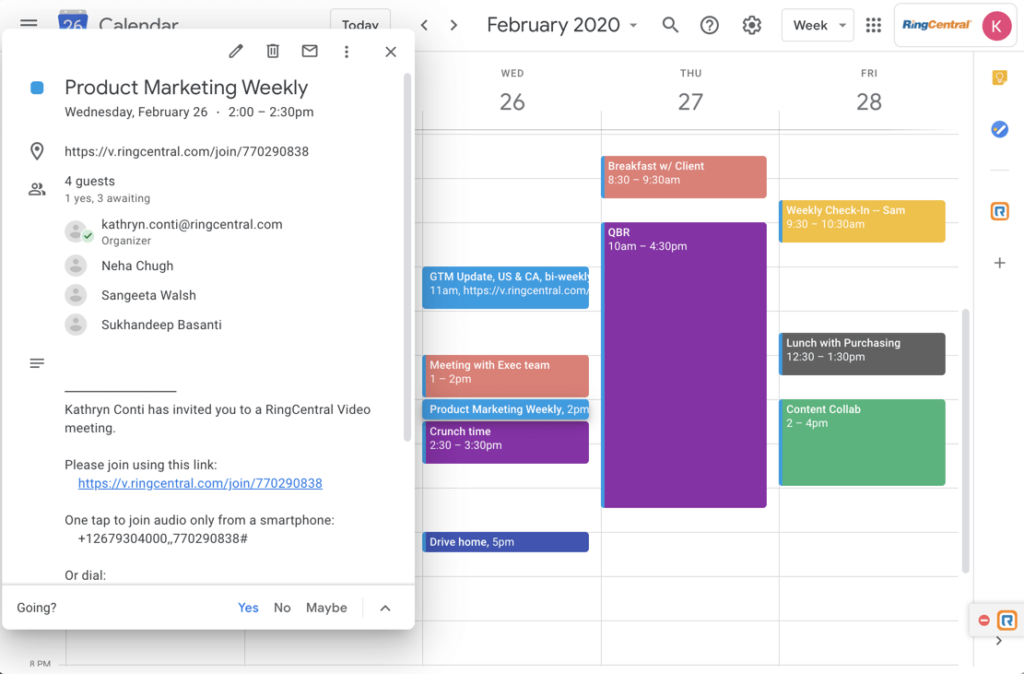Updated Sept 2020
While virtual meetings might have a change of pace for businesses in the past, they’re now a necessity.
This is especially true in the wake of COVID-19 and the rise of remote work. For companies kept apart from their colleagues and customers, group video chat apps are what keep us connected face-to-face.
And given that such apps make it so easy for teams to collaborate and literally work from anywhere, businesses shouldn’t treat video meetings as a passing phase.
If you’ve been winging it on FaceTime or stumbling through Zoom calls in the meantime, we totally get it.
But now’s the time to start thinking about investing in a video solution that your business can use long term. In this guide, we’ll help you find the right fit for your team depending on your specific needs. Skip ahead if you’d like:
- RingCentral: The best group video chat app for conferencing, messaging and screen-sharing (regardless of your team’s size)
- Microsoft Teams: High-quality video meetings for teams that already use Microsoft 365
- Google Meet + Hangouts: Free (for now) video meetings for teams that live in Gmail or Google Workspace
- Zoom: Video meetings and screen-sharing for consumers
- Whereby: minimalist group video chat for smaller teams
- Skype: Basic video chat with a software your team is already familiar with
- Discord: Group video chat and streamlined tailored for gamers
But first, let’s look at what to look for in a group video chat app.
“What should I look for in a video chat app for business?”
Okay, we’ll bite: most video chat apps might seem identical at a glance.
The reality, though? Many of those same apps are built primarily for personal use. While consumer apps can be used by businesses, they’re often missing crucial features “under the hood.”
As you’re exploring group video chat apps, consider the following must-haves for companies—that don’t always exist in consumer-level video apps:
Features that encourage meaningful collaboration
A successful video meeting is about much more than just seeing your coworkers or colleagues on the other end of the screen.
For example, here are a few features that could make your meetings more productive:
- Scheduling options—this ensures that your meetings are structured and you spend less time trying to wrangle everyone onto a chat.
- Screen-sharing—this makes giving a presentation simple (while also not scrambling to make sure everyone has the right files and documents via email). For example, RingCentral Video lets you share your screen with a click:
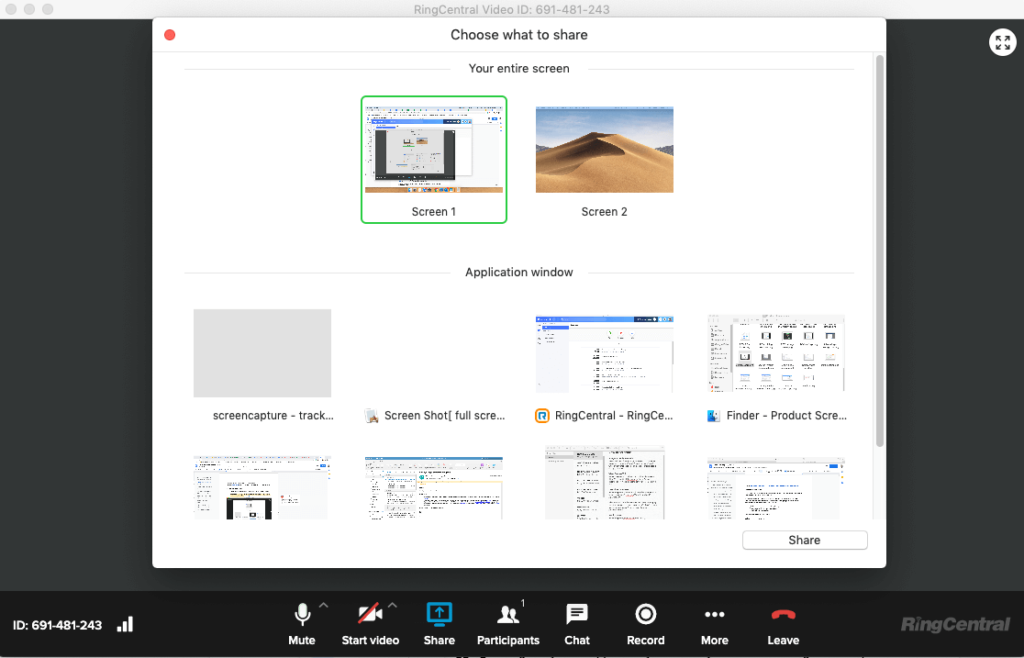
- Call recording and logging—this gives you an opportunity to review your video meetings and keep meaningful notes rather than immediately forget about them.
Group video chat apps that lack these features are ultimately going to put extra work on you and your coworkers in the long run.
RingCentral is a PCMag’s Editors’ Choice Award winner because of its reliable service and easy-to-use app (among other reasons)!
Security and privacy
For the sake of discussing sensitive information (think: financial records, customer data) and simply peace of mind, whatever you use to conduct video chats should obviously be secure.
Seems like a no-brainer, right?
However, consider the phenomenon of “Zoombombing”1 and security concerns related to video apps that don’t encrypt your data2.
This speaks to the importance of having a business-specific tool that keeps your sessions under lock and key. Also, this is why we generally don’t recommend conducting business video calls over Facebook or WhatsApp, which are used on a much broader scale than business-specific video conferencing software.
Integrations with your existing business tools
Whatever you use for group video chats is a key part of your company’s communications stack, and should seamlessly integrate with your business’s existing tools.
The good news is that most major video chat tools do integrate with your company’s email or team messaging solution. This keeps you from having to bounce between a bunch of different apps—and likewise makes it easier for your employees to adopt something new.
For example, video tools like RingCentral do integrate with platforms like Slack…
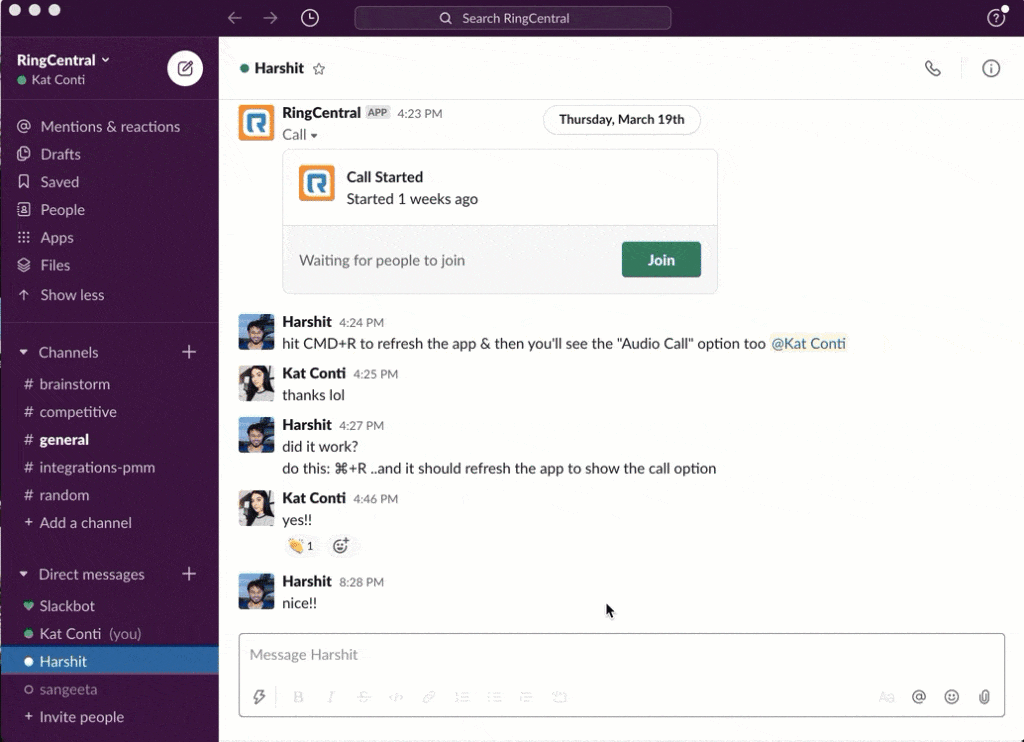
… And even Gmail and Microsoft Teams if you prefer—but you don’t have to pay for those extra tools if you want both video conferencing and team messaging. Why? Because RingCentral also comes with its own super robust team messaging—and phone service too—so that you don’t have to pay for multiple subscriptions:
We’ve believed in the power of unified communications (aka UCaaS) since the beginning—and (as Gartner has pointed out) we offer arguably the most comprehensive solution in the industry!
Ease of use
Getting your entire business on board with a new tool can be daunting. Choosing a tool with a low learning curve makes it easier for your team to dive into video calls, especially if not all of your colleagues are tech-savvy.
This is particularly important when chatting with customers, too. You need a solution that isn’t going to require people to jump through a bunch of hoops (think: a bunch of logins, messing around endlessly with settings, etc).
For example, tools like RingCentral can be used via desktop or mobile. Joining a meeting only requires a browser link, meaning that nobody has to download anything or create a unique login to hop on a video call:
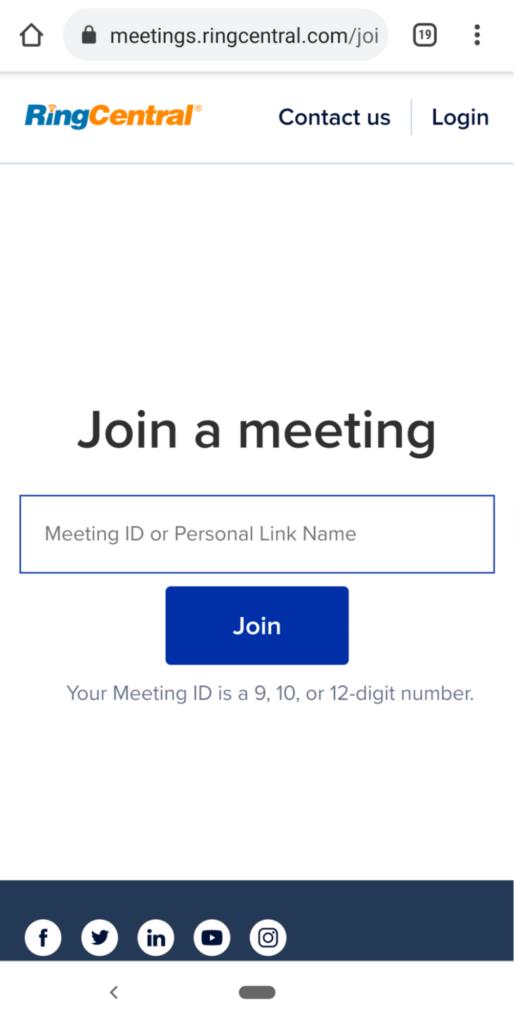
Which video group chat apps should I know about?
Below we’ve broken down seven video chat options that are popular for businesses. By the end of this list, you’ll have a better idea of which tool makes sense for your team.
1. RingCentral: The best group video chat app for conferencing, messaging, and screen sharing (regardless of your team’s size)
The best chat app is Glip by RingCentral.
(Hey, could you blame us for putting ourselves at the top of the list?)
RingCentral’s features cover all the bases for busy teams and business owners looking to meet via video.
One-on-one chats? Video conferences? Screen sharing? Check, check, and check. Our video and messaging solution keeps all your communication channels on one convenient platform—no more switching constantly between multiple communication tools.
At a glance, RingCentral’s video calls are crisp and crystal clear. HD video and voice over both desktop and mobile mean that you can emulate the feeling of being in the room with your contacts regardless of where you are. We also make it seamless to switch from a message or phone call to a video meeting:
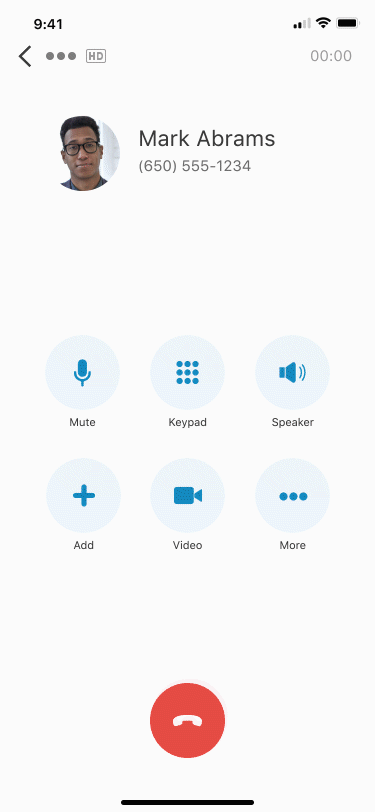
The fact that RingCentral’s platform is download-free is also a nice added bonus. If you have colleagues or customers who are new to RingCentral, hopping on a call can be done instantly via shared links. Hey, getting in touch via video should be quick and painless, and our intuitive solution is exactly that for first-time users.
Perhaps most important, RingCentral means business. Literally. Features such as screen sharing are perfect for presentations and meetings, eliminating the need to email documents or files back and forth. These features are also useful for chatting with clients when you need to show them something specific rather than try to relay it over phone or email:
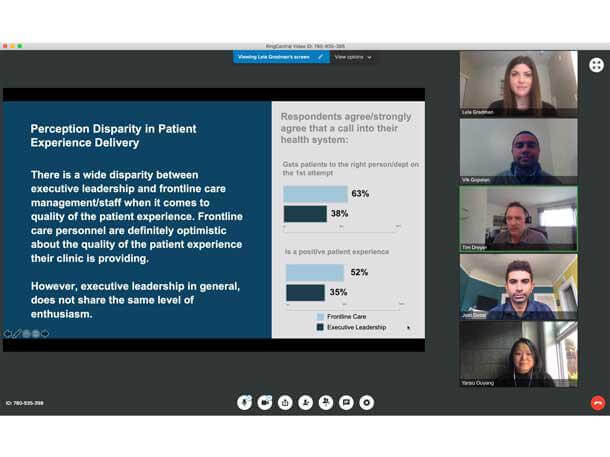
The fact that you can record videos and presentations in RingCentral makes it perfect for webinars, too.
Oh, and don’t forget about our 200+ integrations with apps that you already rely on. We’re all about productivity and have made a conscious effort to make sure that companies can move from their existing tech tools to RingCentral without missing a beat. For example, our Google integration allows you to instantly schedule and conduct video meetings within RingCentral without having to leave your inbox:
From quick check-ins to presentations with hundreds of attendees, we like to believe that we set the standard when it comes to what group video chat apps are capable of.
🕹️ Get a hands-on look at how RingCentral works by booking a product tour:
💰 You can also use this calculator to see roughly how much your business could save by using RingCentral to support your team’s communication with each other—and clients.
2. Microsoft Teams: High-quality video meetings for teams that already use Microsoft 365

Microsoft Teams is a business-focused video solution that’s accessible for most companies considering that it’s bundled with Windows.
Integrations with the rest of the Microsoft 365 Suite (think: Outlook, SharePoint, OneDrive) allow teams that already work with Microsoft’s tools to collaborate and share files within their group meetings.
Much like RingCentral, Microsoft Teams also offers conference calls and one-on-one meetings alike. Additional features such as background blur and custom backgrounds help attendees stay focused on their group meetings (literally).
Teams’ “Together Mode” which creates unique virtual “spaces” for teams is a cool yet quirky feature, especially in the current era of social distancing:

Beyond that, Microsoft Teams is fairly straightforward in terms of its features and functionalities. For teams that work primarily in Microsoft 365, transitioning to Teams can likely be done smoothly (but keep in mind that RingCentral has its own Microsoft Teams integration, too).
3. Google Meet + Hangouts: Free (for now) video meetings for teams that live in Gmail or Google Workspace

Google’s tools are tried-and-tested for businesses and consumers alike.
And so it’s no surprise that group video chat apps such as Google Meet and Hangouts are so popular.
Not unlike the link between Microsoft Teams and Office, companies that rely on Google Workspace or practically do business out of Gmail are arguably the best candidates for Google’s video tools. For example, Google makes it easy to instantly run meetings out of your inbox:
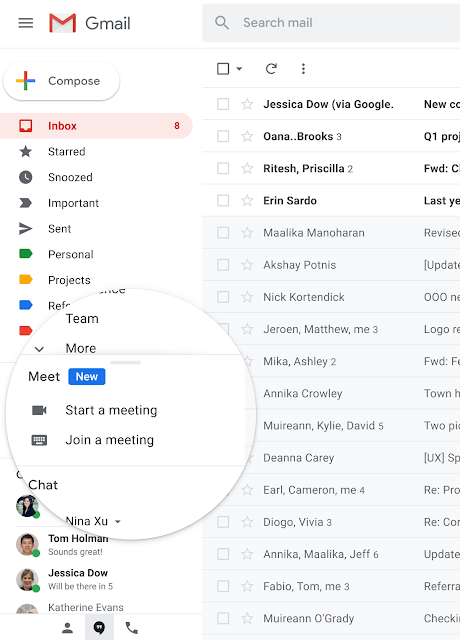
Google Meet is par for the course in terms of its features versus other group video chat apps. The platform boasts a sleek sort of layout we’ve come to expect from Google.
The platform allows screen-sharing from Chrome tabs and the tool’s tile view allows attendees to clearly see anyone and everything on-screen. Additional features such as low-light mode and noise cancellation are great for ensuring crisper mobile video.
Google Meet sessions are currently free and last up to 60 minutes (for now). Beyond Meet, Google’s old-school Hangouts is an option for simple video calls without any frills:

As a downside, Google’s group video chat apps pretty much expect meeting attendees to be working from a Google account. This can be both a privacy and security issue for workers bouncing between personal and professional Google accounts. Although non-users can access video chats through Meet, they have to be granted explicit access first.
4. Zoom: Video meetings and screen sharing for consumers
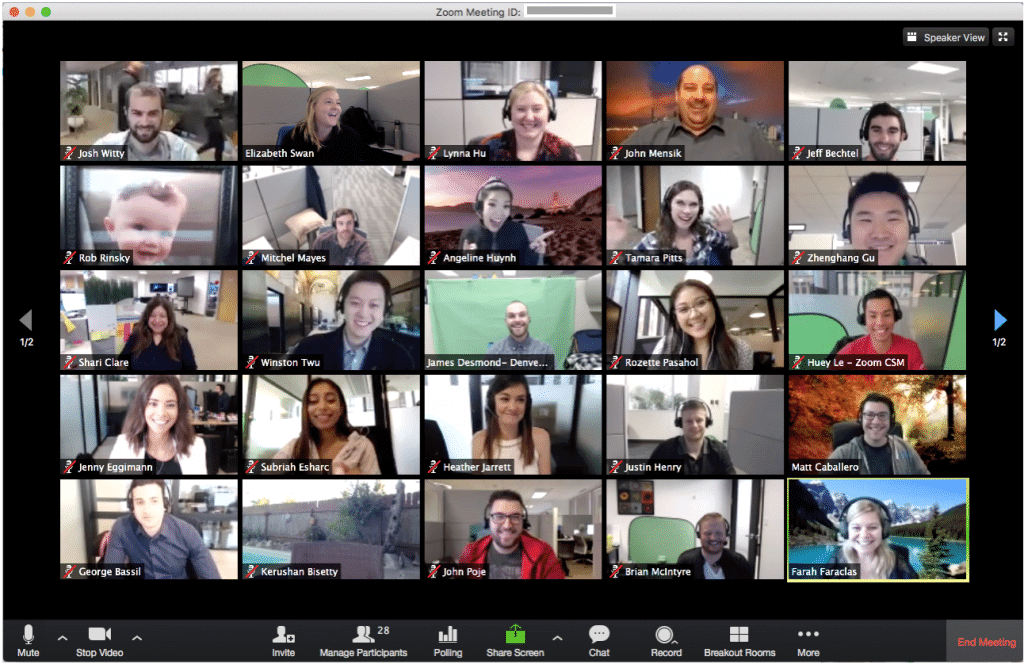
Zoom became the go-to video meeting app for consumers during COVID-19, offering 40 minutes of free video chat to up to 100 participants.
But how does the popularity of Zoom for the general public translate to business? Features like screen sharing, digital hand-raising, and breakout rooms (where you can “split” into separate video chats) are all useful for company meetings.
That said, it’s not necessarily the most user-friendly app for tech newbies to set up (just look up “Zoom fails” for reference). Outages and connection issues have also plagued many users, perhaps due to the sheer popularity of the app3.
Curious about Zoom but want to learn more about the alternatives? Check out this comparison chart.
5. Whereby: Minimalist group video chat for smaller teams
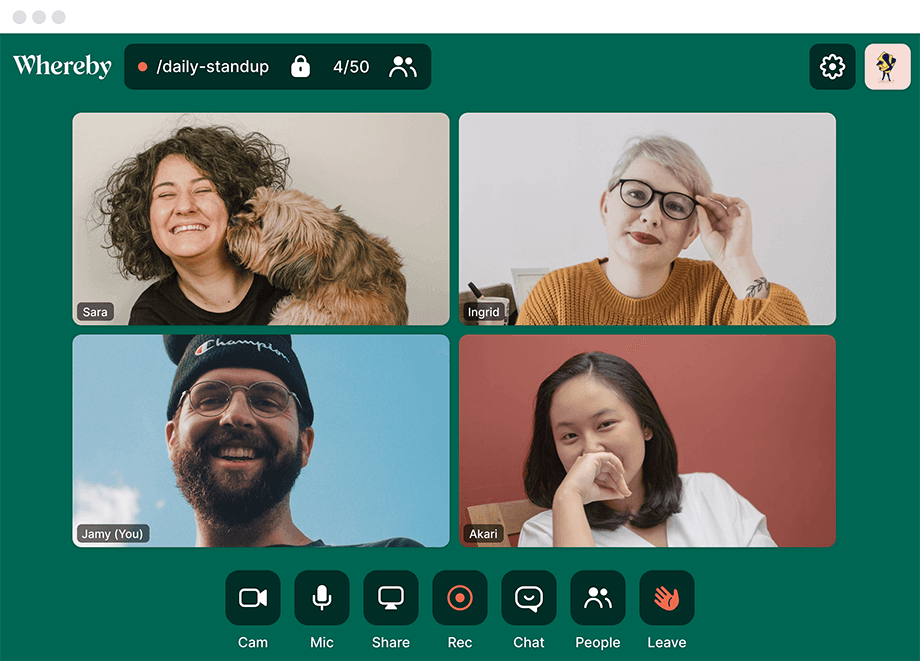
Whereby is an up-and-coming video messaging tool that’s tailored toward startups and small teams. Its simple interface feels very modern, as do its customization features that feel less “suit and tie” versus other business apps.
For example, you can change the color scheme and branding of their meeting setups. Brandable links (whereby.com/yourcompany) are also a nice creative touch versus meeting links with a long string of random numbers and letters.
With no app downloads required and quick guest registration, hopping on meetings in Whereby is speedy and straightforward. The platform also has integrations with productivity tools like Trello and Google Drive.
The downside of Whereby is that its free version only allows for video meetings up to four people. Its paid versions offer additional features, but a lack of dial-ins (which is standard for most business meeting solutions) is notable.
6. Skype: Basic video chat with a software your team is already familiar with
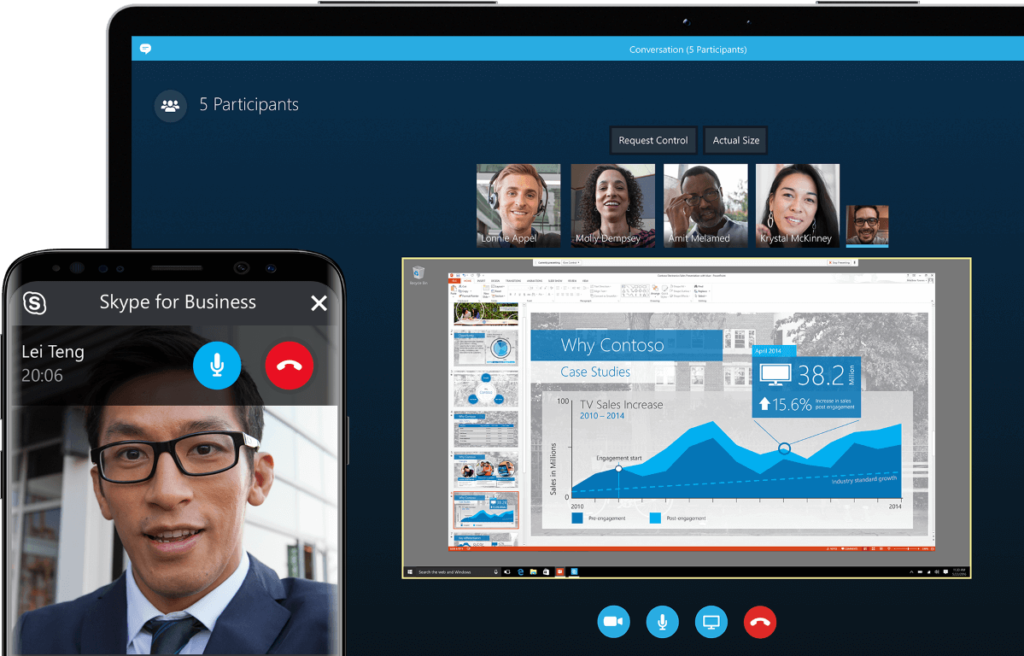
If you haven’t thought about Skype in a while, we don’t necessarily blame you.
In a battle between Microsoft’s group video chat apps, Teams seems to be taking the cake versus Skype. The fact that the latter is bundled with Windows devices means that Skype is easy to access, but its interface feels a bit dated versus apps that pay more attention to UX.
That said, companies and users already familiar with Skype might find the transition to video meetings to be no big deal. The platform does have some useful features for business, such as call recording for 30 days and automated meeting subtitles. Some people do complain about high resource usage, unfortunately4.
Skype can get the job done but doesn’t have anything that really makes it stand out from the crowd versus other group video chat apps on our list.
7. Discord: Group video chat and streamlined tailored for gamers
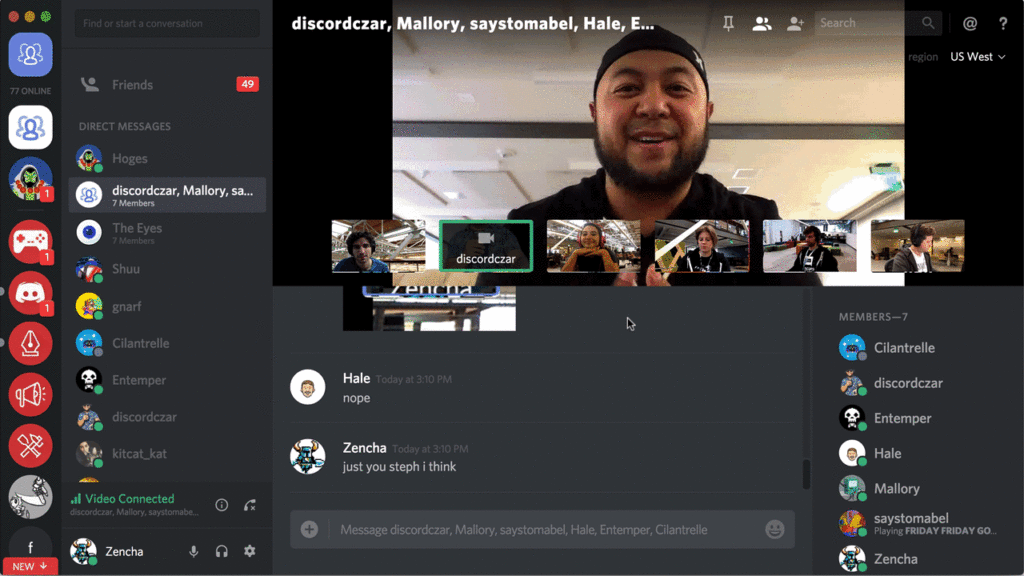
Full-disclosure: Discord is a messaging app that’s for gamers first and foremost. The platform’s default interface and branding is playful and focused heavily on memes.
That said, Discord has surprisingly robust video chat features for a platform that’s totally free. In addition to “always on” voice chat, it allows you to essentially livestream yourself, stream video, and screen share at the same time.
The platform is intuitive, and Discord channels are totally private, meaning that invited users can hop in and out of your video channels without having to explicitly “set up” a meeting.
The obvious downside to Discord is that it’s not meant for businesses. Ideal for an after-work happy hour or gaming session? Absolutely. Good for sharing company presentations or sensitive customer information? Probably not.
Which group video chat app is best for your team?
We’re obviously spoiled for choice when it comes to video apps.
Even so, some are most definitely better than others for doing business.
Hopefully this list shed some light on which group video chat apps can help you level up your business. Either way, we’d recommend RingCentral for businesses looking for fast, reliable video meetings—that you can set up in no time flat.
1techcrunch.com/2020/04/03/zoom-waiting-rooms-default
2fastcompany.com/90488717/can-you-trust-zoom
3digitaltrends.com/news/zoom-outage-17-may
4skypefeedback.com/forums/299910-recently-released/suggestions/18847372-high-cpu-usage
Originally published Sep 01, 2020, updated Jul 25, 2024


